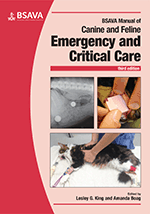
Full text loading...

Cardiopulmonary resuscitation (CPR) continues to command a great deal of interest. Evidence suggests that cardiac arrest could be survivable for a considerably higher proportion of veterinary patients. This chapter provides the most important principles and guidelines on small animal CPR; covering preventative measures, preparedness measures, recognition of cardiopulmonary arrest and initiation of cardiopulmonary resuscitation, basic and advanced life support, post-cardiac arrest care and prognostication.
Cardiopulmonary resuscitation, Page 1 of 1
< Previous page | Next page > /docserver/preview/fulltext/10.22233/9781910443262/9781910443262.20-1.gif

Full text loading...








